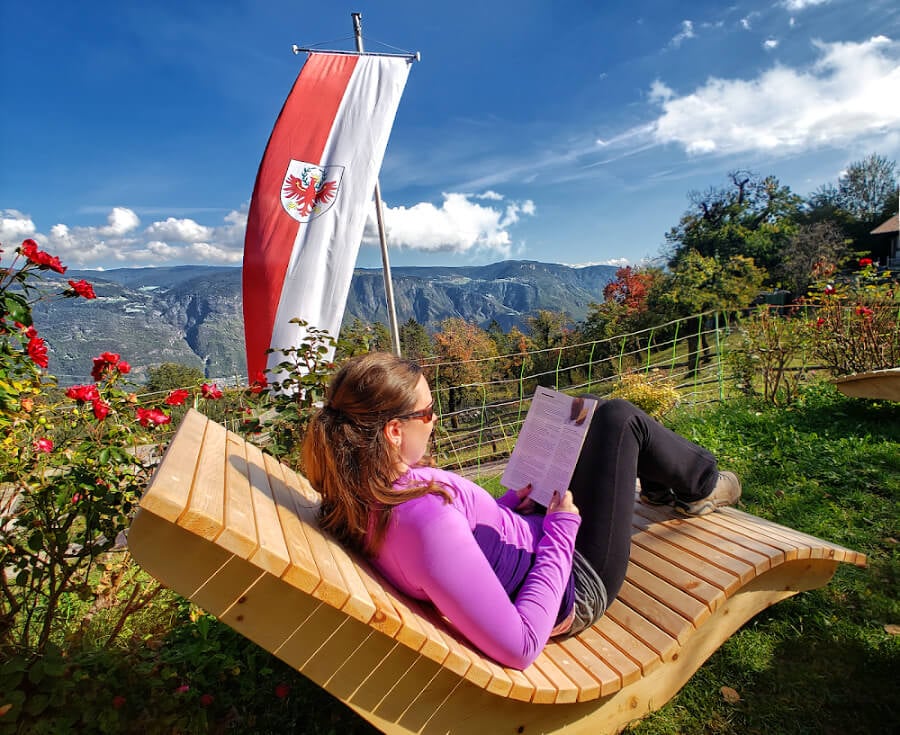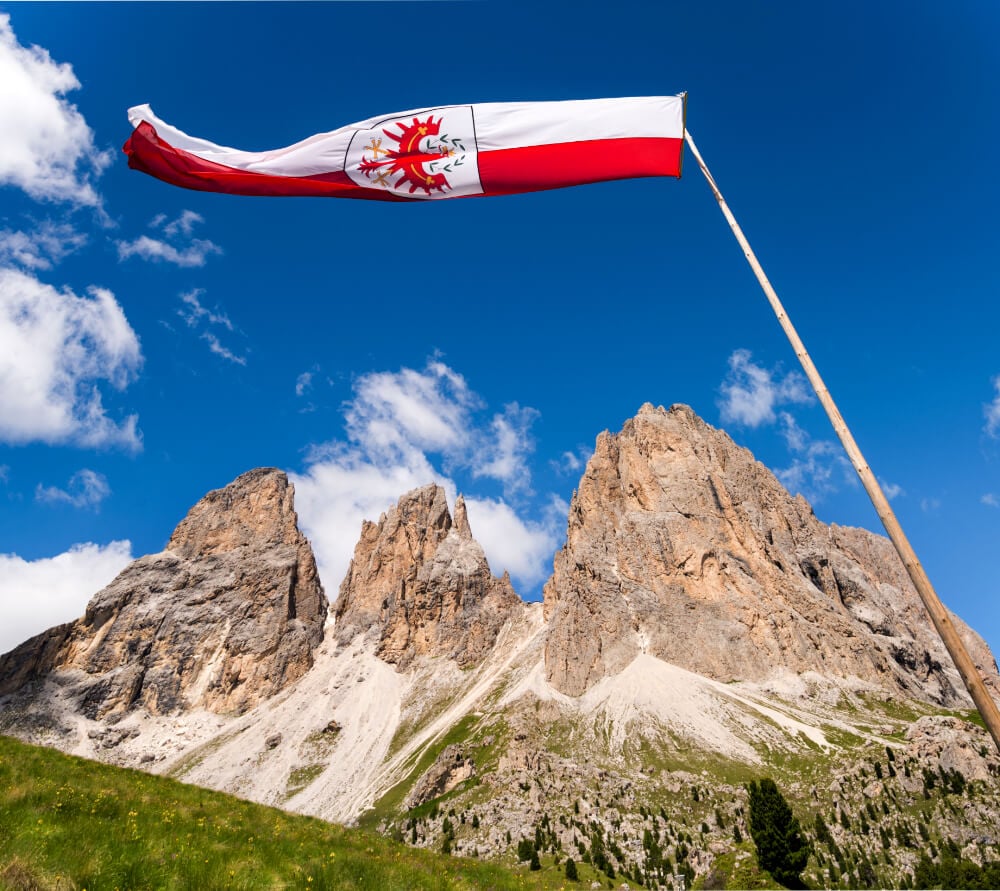
Explore the legacy of South Tyrol’s flag, featuring the brilliant red Tyrolean Eagle, a coat of arms steeped in history that has profoundly shaped the region and its people.
Wander anywhere in South Tyrol, from the lushest of valleys to the craggiest of peaks, and you’re certain to lock gazes with its ancient emblem. The Tyrolean Eagle makes its presence known in majestic and understated manners alike. Whether proudly roosting on red and white banners fluttering in the alpine breeze at mountain huts in the Dolomites, or soaring on castle walls wearing centuries of ruin, this fiery heraldic crest is sure to ignite your curiosity when visiting the region.
In this post, we share a few of the fascinating details surrounding South Tyrol’s age-old insignia. Knowing a slice of the region’s past before traversing its paths will infuse your trip with richer meaning — creating bonds that will resonate long after you’ve bid farewell to its vistas.
CONTENTS OVERVIEW
About Coats of Arms
According to historians, coats of arms arose during the 11th century. Ironclad warriors of the time adorned their shields with these symbolic representations, not only as vanity pieces to trumpet their victories but also as a billboard meant to strike fear in their foes on the battlefield.
Originally, each emblem was as distinct as the knight it represented, a vivid chronicle of personal feats etched onto their protective armor. However with time, they evolved into standard markers, flag bearers of familial lineage, and signifiers of allegiance to a throne.

By the 13th century, coats of arms were commonplace — stirring a sense of dread or pride depending on the viewer. They billowed from banners in the thick of war or snapped in the wind high atop the turrets of fortifications and strongholds. Yet, the power of the coat of arms wasn’t a free-for-all — it was a privileged mark exclusive to the royals, and those anointed by a king or queen.
In those times, when a royal family adopted a coat of arms, it wasn’t merely about choosing an emblem. It was an assertion of their lineage, their power, their distinct identity, and the sphere of influence they held. The claiming of a coat of arms was tantamount to staking a claim on a heritage that would reverberate through time as it was passed down from one generation to the next.
Red Eagle Rising

Stepping into the antiquity of Tyrol Castle, erected in the 1100s, you encounter the earliest known manifestation of the Red Eagle, South Tyrol’s heraldic beast. This austere fortress served as the cradle for the Counts of Tyrol, a lineage that accrued such tremendous influence, it not only crowned a land but named it. Imagine that — an entire region christened by a castle, an honor that no other fortress in Europe can boast.
The ancient echo of the Red Eagle’s cry resonates from above a chapel portal within the castle’s stout walls. Rendered in fresco, the emblem, even after almost a millennium of the merciless march of time, retains much of its fiery red plumage. You can’t help but envision the vivid spectacle it would have been when it first met the eyes of the knights that once paced these historic halls.

Witnessing the coat of arms within the hallowed confines of Tyrol Castle imbues it with an aura of mystique. It leaves you with a profound appreciation for why those hailing from this region identify as Tyrolean first, above Italian or Austrian. It’s more than a symbol — it’s a declaration of identity, as enduring and unyielding as the castle walls themselves.
And when you step away from the castle’s towering presence, you can’t help but carry a piece of that raw, Tyrolean spirit with you. It finds a home in your memory — infusing a deeper, richer understanding of this fiercely independent corner of the world. As the South Tyrolean landscapes pass by, from the sky-piercing Dolomites to the verdant vineyard-clad valleys, you start to see the region through a different lens. Every mountain peak, every stone-hewn castle, and every chiseled face you encounter seems to reflect the defiant, enduring essence of the Red Eagle.
⇒ YOU MIGHT ALSO LIKE: Discover Burg Taufers: Titan of the Tyrolean Alps
The Outlaw Hero of Tyrol
The Red Eagle of South Tyrol has, through centuries, been a beacon of freedom, its wings symbolically spread against the winds of oppression. The early 1800s offered a stage for its most poignant demonstration, when Andreas Hofer, a Tyrolean patriot, mustered the common folk to rise against the French and Bavarian rule.

Hofer, born and raised in Passeiertal, an idyllic valley lying north of Merano in South Tyrol, was not your typical revolutionary. He was an ordinary man with an extraordinary gift for words and an infectious charisma. When he thundered, “Men, the time has come!”, his fellow countrymen sprang to arms, their hearts ablaze. Hofer’s unwavering resolve, his fearlessness, and his profound love for Tyrol stirred a fire of heroism and sacrifice in thousands of hearts.
Napolean, sensing the mounting threat, slapped the label of outlaw on Hofer, going so far as to put a price on his head. This led to Hofer’s betrayal by a fellow countryman, Franz Raffl, who would henceforth be known as the “Judas of Tyrol”.On a bitter January day in 1810, Napoleonic forces seized Hofer from a mountain hideaway, nearly 5000 feet above the tranquil hamlet of St. Martin.

Despite Hofer’s capture, his spirit remained unbroken. Barely a month after his capture, under Napoleon’s express orders, Hofer was led to his execution by firing squad. His courage didn’t waver. He refused to kneel. He refused to be blindfolded. Instead, he stared down his executioners, his gaze unflinching. When the commanding officer hesitated, caught in the moment’s gravity, it was Hofer who issued the fatal command, his voice booming, “Fire!”.
Even in certain death, he blazoned forward brandishing rare bravery few can muster. Hofer’s valiant stand wasn’t an end, but the birth of a legend. A legend that, to this day, echoes through the valleys and dances on the peaks of South Tyrol, forever inscribed in the annals of this rugged, beautiful land.
An Ode to the Tyrolean Eagle

As much as the Tyrolean Eagle inspired the spirit of freedom long ago, it still does today. Such is the power of South Tyrol’s coat of arms.
It forms an unbroken chain of reverence and connection. A symbol of unity, of identity, and of a timeless legacy that keeps beating its wings in the hearts of South Tyroleans. In fact, many can still recite the following age-old ode to this winged warrior:
Why Are Thy Plumes So Red?
Eagle, Tyrolean eagle,
Why are thy plumes so red?
“ In part because I rest
On Ortler’s lordly crest;
There share I with the snow
The sunset’s crimson glow.”
Eagle, Tyrolean eagle,
Why are thy plumes so red?
“ From drinking of the wine
Of Etschland’s peerless vine;
Its juice so redly shines,
That it incarnadines.”
Eagle, Tyrolean eagle,
Why are thy plumes so red? “
My plumage hath been dyed
In blood my foes supplied;
Oft on my breast hath lain
That deeply purple stain.”
Eagle, Tyrolean eagle,
Why are thy plumes so red?
“From suns that fiercely shine,
From draughts of ruddy wine,
From blood my foes have shed,—
From these am I so red.”
The Tyrolean Eagle Across the Land
South Tyrol doesn’t lack stunning sights to capture no matter where you wander in this Alpine-Mediterranean wonderland. Yet, amid all this mountainous splendor, the Red Tyrolean Eagle is a constant; an emblem that, whether blazing down from the skies or crafted with a minimalist’s touch, hums with a thousand years of history… especially when you encounter it in places such as the cobblestone alleyways of Bolzano, the knightly halls of Burg Taufers or snapping defiantly in the wind above on any of the other 800 castles in South Tyrol.
Here’s a collection of encounters we’ve had with the Red Tyrolean Eagle during our travels. Whenever we cross paths with South Tyrol’s coat of arms, it always commands our lenses’ attention. These aren’t your typical postcard scenes; they’re simply unique, just like the eagle itself. Just like South Tyrol.














Do not be surprised to find yourself also under the spell of the eagle when you visit the region. Whether attending an Almabtrieb festival or trekking a remote trail, like us, you may even instinctively reach for your camera every time that Red Tyrolean Eagle appears in your field of view.
Don’t resist its pull. Allow it. Because with each frame you capture and each image you share, you are not merely documenting South Tyrol. You’re weaving your own threads into its rich, vibrant tapestry, becoming a part of a narrative that spans centuries. No longer just an observer, you’re an active participant in the enduring saga of the region.
